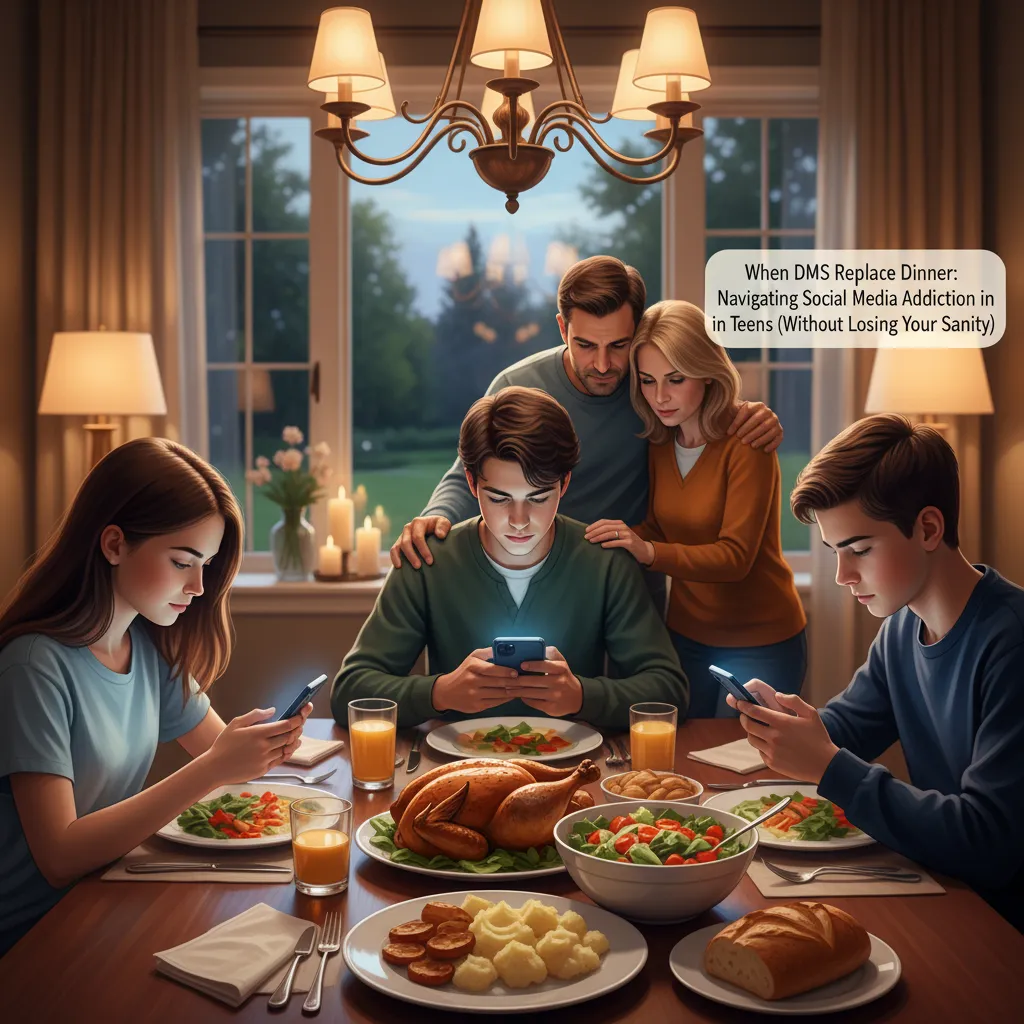Let me let you in on a little secret: last week, I tried to get my daughter’s attention at dinner, only to discover she was deep in a TikTok rabbit hole. I waved, I called her name, heck, I even danced behind her—but nothing worked. If you’ve ever battled for your teen’s focus (and lost against the glowing rectangle), you’re not alone. Let’s unravel the not-so-obvious reasons teens scroll for hours, and what you can realistically do about it (without just confiscating every device in sight).
Why Your Teen’s Brain Loves Scrolling: Dopamine and Endless Feeds
If you’ve ever wondered why your teen can’t seem to put their phone down—even when dinner is on the table—you’re not alone. The truth is, social media platforms are designed to be extremely addictive. These platforms aren’t just apps—they’re billion-dollar media companies. Companies built on decades of behavioral research and with billions of dollars of funding. A huge chunk of that money is spent figuring out how to keep your teen scrolling, clicking, and craving more. This isn’t a character flaw in your child; it’s a system engineered to hook them, often without them even realizing it.
Dopamine: The Brain’s Reward Chemical
Let’s talk about dopamine. Every time your teen gets a like, comment, or new follower, their brain releases dopamine—the “feel good” chemical linked to pleasure and reward. For teens, this effect is even stronger. Research by Dr. Lauren Sherman shows that when teens receive likes on their posts, the reward centers in their brains light up. It’s a kind of neurological high that’s hard to resist. This is why so many teens check social media constantly—sometimes every waking hour—chasing that next dopamine hit.
Algorithms: The Invisible Hand Behind Teen Screen Time
Behind every endless feed is a powerful algorithm. Apps like TikTok and Instagram use these algorithms to curate content with laser precision, serving up videos and posts that are almost impossible to ignore. The goal? To maximize engagement and keep your teen on the app as long as possible. This is why teen screen time averages 5–7 hours a day, with some teens pushing past 9 hours. The more your teen interacts, the more the algorithm learns, and the harder it becomes to stop scrolling.
Short Videos, Endless Feeds, and the ‘Just One More’ Trap
Short, highly engaging videos are another secret weapon in the battle for your teen’s attention. Each clip is designed to be just long enough to keep your teen interested, but short enough to make it easy to watch “just one more.” Before you know it, hours have slipped by. This pattern creates a powerful social media addiction loop, reinforcing compulsive checking and making it even harder to unplug.
Wild Card: The Dinner Table Disappearing Act
Imagine if social apps came with a warning label: “May cause dinner table invisibility.” It’s not far from reality. The instant gratification from notifications and the endless scroll can make your teen seem like they’ve vanished—even when they’re sitting right in front of you.
Anecdote: The ‘Five More Minutes’ Phenomenon
Here’s a familiar scene: My own teen once promised, “Five more minutes, I swear!”—only to emerge from their room 57 minutes later, eyes glazed and barely aware of the time. This isn’t laziness or defiance; it’s the result of apps engineered to keep them hooked.
Social media platforms are designed to be extremely addictive. These platforms aren’t just apps—they’re billion-dollar media companies. Companies built on decades of behavioral research and with billions of dollars of funding.
- Dopamine social media: Likes and comments trigger powerful reward loops.
- Teen screen time: Teens average 5–7 hours daily, with some over 9 hours.
- Social media addiction teens: Algorithms and short videos make stopping hard.
- Social media addiction psychological factors: Instant gratification and habit loops drive compulsive use.

Spotting the Sneaky Signs: Dependency, Anxiety, and Why Grades Drop
When it comes to social media addiction in teens, the warning signs aren’t always obvious. It’s not just about spending “too much time” online. The real signs of social media dependency can be subtle—think anger, secrecy, anxiety, and even physical complaints like headaches or trouble sleeping. Understanding these signals can help you spot when social media is crossing the line from fun to harmful.
Emotional and Behavioral Red Flags
- Defensiveness and Anger: Does your teen get upset or irritable when you ask them to put their phone away? This reaction is a classic sign of social media addiction effects.
- Secrecy: Teens may hide their screens, lie about how much time they spend online, or become defensive when asked about their social media use.
- Constant Checking: Compulsive checking—even late at night or first thing in the morning—signals dependency. Some teens even wake up in the middle of the night to check notifications.
- Guilt and Loss of Control: Feeling guilty about time spent online but being unable to stop is a strong indicator of addiction.
Social Media Self-Esteem Anxiety: The Comparison Trap
Frequent social media use, especially on platforms like Instagram, can lead to constant self-comparison and FOMO (fear of missing out). This is particularly tough for girls, who are at higher risk for anxiety and self-esteem issues linked to social media. Teens may:
- Compare themselves to influencers or peers, leading to low self-esteem
- Feel anxious if they don’t respond to messages right away
- Experience mood swings or irritability after scrolling
Study after study shows that excessive social media use among teenagers is associated with depression, anxiety, low self-esteem, and even body image issues.
Academic and Social Consequences
- Slipping Grades: Social media addiction consequences often include a drop in academic performance. Teens may struggle to concentrate, procrastinate on homework, or stay up late, leading to fatigue and poor grades.
- Neglected Hobbies: Activities that once brought joy—sports, music, reading—may fall by the wayside.
- Awkwardness Offline: Teens may feel less comfortable in face-to-face situations, preferring online interactions over real-life friendships.
Physical Symptoms: The “Social Media Hangover”
After a late-night scrolling binge, your teen might wake up groggy, with tired eyes, headaches, or neck pain. These physical symptoms are real and common among heavy users. Fatigue, irritability, and even withdrawal symptoms (like mood swings or boredom when not online) are all signs social media dependency is taking a toll.
Quick Checklist: Is It More Than Just “A Phase”?
- Does your teen wake at night to check their phone?
- Do they lie about their social media use?
- Have they lost interest in hobbies or friends?
- Do they feel guilty but can’t stop scrolling?
Recent social media addiction statistics show that problematic use among teens rose from 7% in 2018 to 11% in 2022. About 70% of U.S. teens struggle with some level of social media addiction, with girls reporting higher rates of anxiety, depression, and low self-esteem. Watch for these signs—early recognition is key to helping your teen regain balance.

From Confrontation to Collaboration: Outwitting the Scroll Together
When it comes to managing teen screen time and building healthy social media habits, the real magic happens when you move from confrontation to collaboration. Instead of launching into lectures or arguments, try starting with a calm, open conversation. Schedule a relaxed time—maybe after dinner or during a weekend walk—so you and your teen can talk tech without the blame game. Let them know ahead of time, so they can prepare and feel respected.
Start with Conversation, Not Drama
Begin by asking open-ended questions like, “How does using social media make you feel?” or “What do you enjoy most about it?” Avoid interrupting, criticizing, or jumping in with solutions. Just listen. The goal is to understand, not to judge. As understanding grows, frustration fades—and trust builds. This is the foundation for any real change in screen time strategies.
Co-Create Boundaries: Buy-In Beats Rebellion
Involving your teen in setting boundaries is a game-changer. Discuss together what limits make sense—like no social media after 9:30 p.m., or making the dinner table a device-free zone. Talk about privacy, too: what’s okay to share online, and what’s not. Make these boundaries clear, but stay open to adjusting them as your teen grows. When your teen helps set the rules, they’re much more likely to stick to them.
- Timing: Set agreed-upon hours for social media use.
- Place: Establish device-free family routines—meals, movie nights, or one hour before bed.
- Privacy: Discuss what’s appropriate to post or share online.
Try a Family Digital Detox
Device-free family rituals are proven to reduce screen time and boost connection. Imagine a weekly “digital sabbath”—all devices off, everyone in the kitchen making homemade pizza together. It might feel chaotic at first, but these moments create new rituals and real conversations. Remember, digital detox families don’t aim for zero screens, but for strategic breaks and shared activities that matter.
Model the Behavior You Want to See
Teens don’t listen to what we say, they watch what we do. So, be fully present with your teens and prioritize real life moments.
If you’re checking your phone at stoplights or scrolling at the dinner table, your teen gets the message—no matter what you say about healthy social media habits. In fact, 88% of teens say that parents checking their own phones makes family boundaries feel unfair. Show your commitment by using screen time limiters yourself and being present during family time.
Support, Not Surveillance
Many teens use social media to cope with stress, anxiety, or loneliness. Instead of monitoring every post, offer support: “I’m here for you. Let me know if you ever want to talk about it.” Help them find healthier coping strategies, like sports, art, or just hanging out together. If things don’t improve, seeking professional help—like a counselor or coach—can be a powerful social media addiction intervention.
Wild Card: Make Connection the Priority
Try a family challenge: unplug for an evening, play board games, or cook together. It might get messy, but these device-free zones spark laughter, stories, and connection—everything social media can’t replace.

The Not-So-Obvious Upside: Finding Identity, Support, and Creativity Online
When you hear about social media addiction in teens, it’s easy to picture endless scrolling, lost sleep, and missed family dinners. But let’s make something clear:
Social media itself isn’t evil. Many teens use it to talk to their friends, find communities, or express themselves creatively.For many young people, these platforms are more than just distractions—they’re lifelines for connection, self-discovery, and growth.
Think about your own teen. Maybe they’re not just chatting about homework or sharing memes. Social media can be a powerful tool for teen mental health when used with intention. Teens often find communities online that simply don’t exist in their school or neighborhood. Whether it’s a group for young artists, fans of a niche video game, or teens exploring their identity, these digital spaces can offer understanding and acceptance that’s hard to find offline. Sometimes, the support found on platforms outdoes what’s available in real life, especially for those who feel isolated or misunderstood.
It’s also a place for creativity to thrive. From sharing original art and music to starting advocacy campaigns, social media gives teens a stage to express themselves. This kind of creative outlet can boost self-worth and confidence, especially when their work is celebrated by peers who “get it.” Fostering healthy digital participation doesn’t just keep teens safe—it helps them build skills, friendships, and a sense of purpose.
And don’t underestimate the power of a single online interaction. What if your teen’s next big passion project starts with a random comment on a meme page? I once cheered my son on as he joined an online coding challenge he found through social media. He still talks to that friend halfway around the globe! These experiences can spark lifelong interests, build resilience, and even shape career paths.
Of course, not all social media use is positive. The context and content matter. But when you recognize and encourage purposeful, positive use, you help your teen develop healthy social media habits. Celebrate their digital wins—like finishing a creative project or supporting a friend online—just as much as you celebrate their offline achievements. This balanced perspective can actually strengthen your teen’s motivation to manage problematic use, making it easier to set limits and take breaks when needed.
So, while it’s important to be aware of the risks of social media addiction in teens, don’t overlook the not-so-obvious upside. Help your teen find balanced, healthy communities online, and remember: connection isn’t always dangerous. Sometimes, it’s exactly what they need to grow, thrive, and discover who they are—one DM at a time.
TL;DR: Teens aren’t lazy—they’re up against platforms designed to keep them online. If you want to help, start with understanding and open conversations, not just rules. Small shifts—like family device-free rituals or being tech role models—can go a long way. And if you need more than DIY fixes, don’t hesitate to get professional help.



